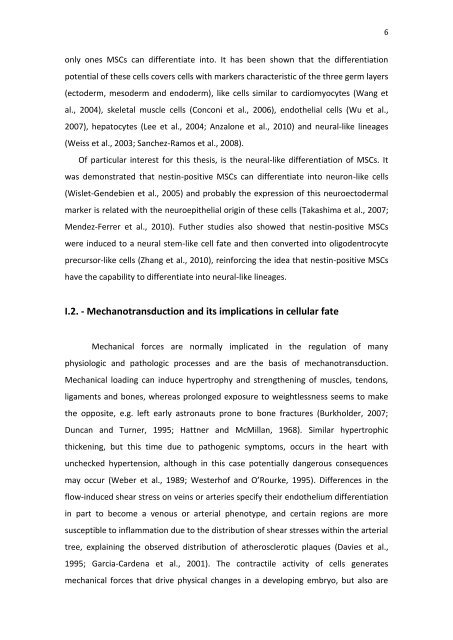DEPARTAMENTO DE CIÊNCIAS DA VIDA ... - Estudo Geral
DEPARTAMENTO DE CIÊNCIAS DA VIDA ... - Estudo Geral
DEPARTAMENTO DE CIÊNCIAS DA VIDA ... - Estudo Geral
You also want an ePaper? Increase the reach of your titles
YUMPU automatically turns print PDFs into web optimized ePapers that Google loves.
6<br />
only ones MSCs can differentiate into. It has been shown that the differentiation<br />
potential of these cells covers cells with markers characteristic of the three germ layers<br />
(ectoderm, mesoderm and endoderm), like cells similar to cardiomyocytes (Wang et<br />
al., 2004), skeletal muscle cells (Conconi et al., 2006), endothelial cells (Wu et al.,<br />
2007), hepatocytes (Lee et al., 2004; Anzalone et al., 2010) and neural-like lineages<br />
(Weiss et al., 2003; Sanchez-Ramos et al., 2008).<br />
Of particular interest for this thesis, is the neural-like differentiation of MSCs. It<br />
was demonstrated that nestin-positive MSCs can differentiate into neuron-like cells<br />
(Wislet-Gendebien et al., 2005) and probably the expression of this neuroectodermal<br />
marker is related with the neuroepithelial origin of these cells (Takashima et al., 2007;<br />
Mendez-Ferrer et al., 2010). Futher studies also showed that nestin-positive MSCs<br />
were induced to a neural stem-like cell fate and then converted into oligodentrocyte<br />
precursor-like cells (Zhang et al., 2010), reinforcing the idea that nestin-positive MSCs<br />
have the capability to differentiate into neural-like lineages.<br />
I.2. - Mechanotransduction and its implications in cellular fate<br />
Mechanical forces are normally implicated in the regulation of many<br />
physiologic and pathologic processes and are the basis of mechanotransduction.<br />
Mechanical loading can induce hypertrophy and strengthening of muscles, tendons,<br />
ligaments and bones, whereas prolonged exposure to weightlessness seems to make<br />
the opposite, e.g. left early astronauts prone to bone fractures (Burkholder, 2007;<br />
Duncan and Turner, 1995; Hattner and McMillan, 1968). Similar hypertrophic<br />
thickening, but this time due to pathogenic symptoms, occurs in the heart with<br />
unchecked hypertension, although in this case potentially dangerous consequences<br />
may occur (Weber et al., 1989; Westerhof and O’Rourke, 1995). Differences in the<br />
flow-induced shear stress on veins or arteries specify their endothelium differentiation<br />
in part to become a venous or arterial phenotype, and certain regions are more<br />
susceptible to inflammation due to the distribution of shear stresses within the arterial<br />
tree, explaining the observed distribution of atherosclerotic plaques (Davies et al.,<br />
1995; Garcia-Cardena et al., 2001). The contractile activity of cells generates<br />
mechanical forces that drive physical changes in a developing embryo, but also are
















